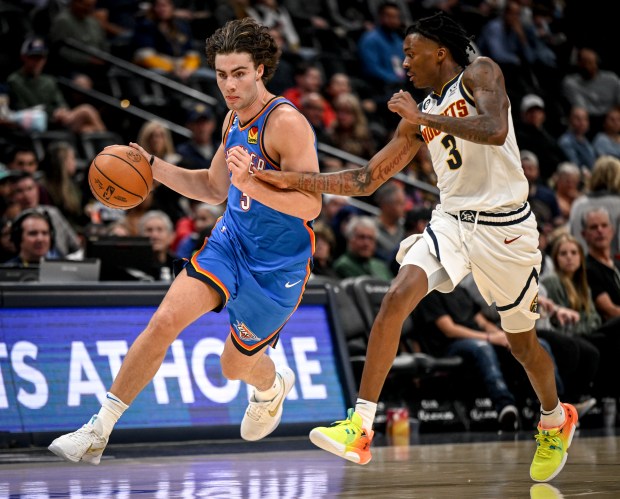It had been nearly 34 months since the Chicago Bulls last made a trade. But this week, the drought finally ended as the front office made what appears to be the first in a series of moves to restructure the roster after another underwhelming season.
Moving Alex Caruso to Oklahoma City in a player-for-player swap for Josh Giddey is a deal that seems to signal executive vice president of basketball operations Artūras Karnišovas might actually stick to his word of “exploring all options” and making changes to the Bulls roster this summer.
But was this the right move — and the right return? Let’s break down the trade and how it affects both teams.
For the Thunder, this is a slam dunk. Like a launch from the free-throw line, put a crack in the backboard slam dunk. Caruso is the type of high-IQ, high-effort defender who will immediately elevate the Thunder, while his 3-point shooting has sharpened enough to bolster one of the best offenses in the league.
In a statement Friday, Oklahoma City general manager Sam Presti said the Thunder had already determined Giddey would need to come off the bench next season, a decision that triggered a trade request.
This doesn’t mean Giddey won’t be able to make an impact. The Bulls are quite familiar with the concept of a change of scenery benefitting players, most recently watching that play out when Derrick Jones Jr. transformed himself from a deep rotational player in Chicago to a crucial starter in an NBA Finals run in Dallas in a single season. But the Thunder essentially swapped a struggling bench project for a ready-made veteran with one championship already under his belt, a major win for a team already prepared to push for a title next season.
How did the Bulls fare in comparison?
It’s a little less clear what the Bulls are getting out of Giddey. He struggled significantly last season shooting from behind the arc, one of the areas where Caruso thrived — and where the Bulls need the most drastic improvement. Giddey shot at a 33.7% clip on three attempts per game and an abysmal 18.8% streak during the Western Conference semifinals that ultimately forced him out of the Thunder starting lineup.
As a playmaker, Giddey has been floated as a prototype “replacement” for Lonzo Ball, who will attempt to become the first NBA player to return following meniscus and knee cartilage transplants. That’s a somewhat unfair framing. Giddey can’t replace Ball as a defender or shooter (although it’s a distant memory, Ball was shooting 42.3% on 7.4 attempts behind the arc before his injury).
But what Giddey can replicate is creation and innovation, something the Bulls have craved in the two years of Ball’s absence. Even after converting Coby White to a starting point guard last season, the Bulls struggled with offensive creativity in the latter half of the season. It’s clear the team could benefit from a true playmaker at the point, which would allow White to flex his growth from the two-guard position.
Giddey is young enough that improvement in his shooting and defense is still a real possibility in the right system. This is clearly an investment piece — and it addresses at least one real need for the Bulls.
Even with this positive outlook, a serious question still lingers: could the Bulls have gotten more out of the Thunder?
Oklahoma City has more draft capital stashed than nearly any team in the NBA, with a handful of first-rounders in 2024 and 2025. The Bulls received offers for Caruso in the form of first-rounders ahead of the trade deadline, but according to a Yahoo Sports report, the front office held out for as many as four first-round picks.
Caruso is such a clear fit for the Thunder it’s hard to believe the Bulls couldn’t have struck a more friendly deal that included one of those first-round picks. Although future value is impossible to predict, it’s hard to argue that Giddey and Caruso are similarly valued at this moment.
The Bulls still have several more assets to deal with — including Zach LaVine and sign-and-trade options for DeMar DeRozan and Patrick Williams — which could offer opportunities to stock up on draft picks and prepare for a future roster build.
But if the front office continues to prioritize player trades, it would provide an interesting perspective into how Karnišovas holistically values the draft as a mechanism to improve.
The most infuriating answer to all these questions is also probably the fairest: we need more time to fully rate this trade. If the Bulls are on the path to blow up — or at least significantly restructure — their current roster, then this deal can only be totally understood in the context of future moves.
Truly restructuring the roster would require the desertion of “competitiveness” this season, with the Bulls realigning their priorities to focus on growth rather than fighting for a play-in tournament spot for the third straight year. And after the last three years of inaction, it’s understandably difficult to believe the front office has arrived at this point.
But if the wheels are finally in motion, the Bulls are likely building toward a new vision for the roster — ideally a younger group that is more versatile and creative, with an improved shot profile from behind the arc.



